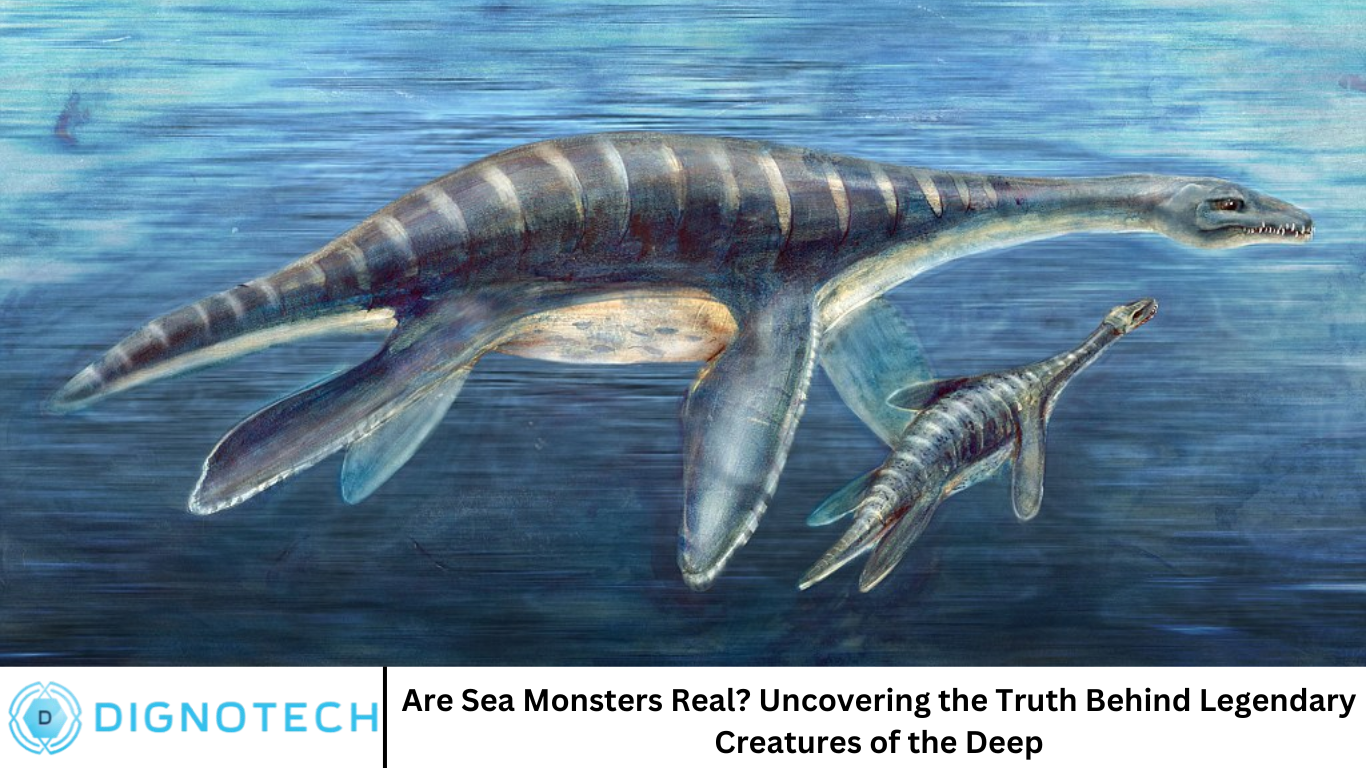Are Sea Monsters Real? Uncovering the Truth Behind Legendary Creatures of the Deep

Hi everyone! How are you all doing? Welcome to dignotech.com! The vast and mysterious depths of the ocean have long been a source of fascination and fear for humans. For centuries, stories of giant sea creatures, ranging from massive serpents to terrifying tentacled beasts, have captured the imagination of sailors, scientists, and storytellers alike. But with all the myths and legends swirling around these creatures, one burning question remains: are sea monsters real?
In this article, we will delve deep into the truth behind the stories of sea monsters. We will explore the historical and cultural origins of these legends, examine the evidence that exists (or doesn’t) for such creatures, and discuss what science says about the possibility of giant sea creatures lurking in the depths.
The Origins of Sea Monster Legends
The idea of sea monsters dates back to ancient civilizations. The earliest references to sea creatures in mythological texts can be found in cultures across the world. In ancient Greece, for example, the myth of the Kraken, a monstrous sea creature with enormous tentacles, captivated the minds of sailors. The Kraken was said to pull entire ships under the sea, dragging their crews to their doom.
Similarly, the Norse mythology speaks of the Midgard Serpent, a giant snake-like creature that encircles the world, waiting for the day when it will rise from the oceans during the Ragnarok – the end of the world. In fact, many ancient cultures had their own versions of sea monsters, with terrifying descriptions of giant serpents, aquatic dragons, and enormous fish.
These early stories likely arose from the fear of the unknown. The oceans, especially in ancient times, were vast, uncharted, and treacherous. Sailors, who ventured far from land, often encountered strange creatures that could have seemed monstrous to them. Creatures like giant squids, whales, and sea serpents may have inspired exaggerated tales, which were passed down through generations.
In addition to mythology, sea monsters also appeared in medieval and Renaissance cartography. Some old maps featured drawings of strange creatures emerging from the sea, marking dangerous or unexplored areas of the world. These depictions served as both warnings and expressions of human curiosity about the unknown.
Modern Sea Monsters: Fact or Fiction?
In the modern era, the concept of sea monsters has evolved. Thanks to advancements in marine biology and technology, we now have a far better understanding of the creatures that inhabit the world’s oceans. However, there are still some mysteries that remain.
Giant Squid and Colossal Squid
Perhaps the most famous “sea monsters” in modern times are giant squids and their even larger cousins, the colossal squids. These creatures were long thought to be mere mythological beings, but in recent decades, they have been proven to exist. The giant squid, in particular, can grow up to 43 feet long, with eyes the size of basketballs.
Although these squid are not likely to attack ships as some legends suggest, their size and appearance have certainly contributed to their portrayal as sea monsters. The colossal squid, which can reach lengths of up to 46 feet, is another example of a creature that was once the stuff of legend. These creatures are typically found in deep waters and are very elusive, making them the perfect candidates for the legends of monstrous sea creatures.
The Megalodon
Another sea monster that continues to capture the public’s imagination is the Megalodon, an ancient shark that lived millions of years ago. This shark, believed to have grown up to 60 feet in length, would have been the apex predator of its time, capable of preying on whales and other large marine creatures. The Megalodon went extinct around 2.6 million years ago, but its size and predatory nature have made it the subject of countless myths and speculative tales.
While there’s no evidence that the Megalodon still exists today, its fossilized remains provide a glimpse into the terrifying power of this ancient sea monster. Some conspiracy theorists and enthusiasts continue to claim that the Megalodon could still be living in the deepest parts of the ocean, but there’s no credible evidence to support these claims. However, the idea of the Megalodon still lurking in the deep has been popularized in books, movies, and documentaries.
The Oarfish
The oarfish is another fascinating creature that has been associated with sea monster legends. These fish, which can grow up to 36 feet long, are often seen near the surface of the ocean, especially after storms. Their long, serpentine bodies and undulating movements can easily be mistaken for sea serpents, which has led to numerous reports of sea monster sightings.
Although the oarfish is harmless and typically resides at great depths, it has nonetheless earned a place in sea monster folklore. In fact, oarfish carcasses have washed up on beaches over the years, sparking renewed interest in the idea that sea serpents might actually exist.
The Loch Ness Monster
One of the most famous sea monsters of all time is the Loch Ness Monster, affectionately known as “Nessie.” This creature is said to inhabit Loch Ness, a large lake in the Scottish Highlands. Descriptions of Nessie often depict a long, serpentine creature with humps protruding from the water.
While thousands of people claim to have seen the Loch Ness Monster over the years, scientific investigations have found little to no evidence of its existence. Many supposed sightings have been debunked as hoaxes or misidentified animals, such as otters, seals, or waves. However, Nessie remains a beloved figure in popular culture, and the legend of the Loch Ness Monster continues to attract tourists and enthusiasts to the area.
Other Sea Creature Sightings
Throughout history, sailors and fishermen have reported encounters with strange and unknown creatures. Many of these sightings can be explained by the discovery of unusual marine life, such as deep-sea fish, sharks, and other species that are rarely seen by humans. However, there are still reports of mysterious creatures that defy easy classification.
For example, in 2013, a video surfaced showing a large, unidentified creature off the coast of Japan. Some viewers speculated that it was a sea serpent, while others suggested it was an unknown species of whale or giant squid. Without a clear identification, the creature’s true nature remains a mystery.
The Science Behind Sea Monsters
While many legendary sea monsters have been debunked or explained by known marine life, there are still mysteries that continue to fascinate scientists. The ocean is vast, and much of it remains unexplored. It’s possible that some creatures, particularly those that live in the deep ocean, have yet to be discovered by humans.
Marine biologists have long been fascinated by the diversity of life that exists in the ocean’s depths. Deep-sea creatures like the anglerfish, giant squid, and deep-sea jellyfish have evolved to survive in extreme conditions, often looking like something out of a science fiction movie. These creatures’ strange appearances and behaviors only add to the mystique of the ocean and fuel speculation about the existence of even stranger beings lurking in the deep.
However, despite the potential for undiscovered species, it is unlikely that truly “monstrous” sea creatures, like the ones depicted in myths and legends, exist today. The deep ocean is home to some of the most mysterious and bizarre life forms on Earth, but these creatures are typically small, elusive, and specialized for their environments. The idea of giant, ship-eating sea monsters is far more the stuff of myth than science.
Frequently Asked Question
What are some examples of real sea monsters?
Real sea monsters are typically large, often elusive creatures like giant squids, colossal squids, oarfish, and deep-sea creatures such as anglerfish and deep-sea jellyfish.
Is the Loch Ness Monster real?
There is no scientific evidence to support the existence of the Loch Ness Monster. Many sightings have been debunked as hoaxes or misidentified animals. However, the legend remains popular.
Could the Megalodon still be alive?
There is no credible evidence to suggest that the Megalodon is still alive. It went extinct millions of years ago, and modern-day shark species do not match its size or characteristics.
Are giant squids dangerous?
Giant squids are not dangerous to humans. They are deep-sea creatures and are more likely to be encountered in their natural habitat at great depths. They are not aggressive toward humans.
Why do sea monsters appear in myths and legends?
Sea monsters in myths and legends were often inspired by the fear of the unknown. Sailors encountered strange creatures that seemed monstrous, and these encounters were exaggerated into stories and myths.
Could there be undiscovered creatures in the ocean?
Yes, the ocean is vast and largely unexplored. It’s possible that undiscovered species exist, especially in deep-sea environments. However, they are unlikely to be the giant, ship-eating creatures of legend.
What is the most famous sea monster?
The Loch Ness Monster is perhaps the most famous sea monster in modern legend. Other famous creatures include the Kraken, the Midgard Serpent, and various sea serpents reported throughout history.
Conclusion
So, are sea monsters real? In a sense, yes. There are many creatures in the ocean that could be considered “sea monsters” by the standards of ancient sailors and explorers. Giant squid, colossal squids, oarfish, and other large, mysterious marine animals have existed throughout history and continue to fascinate scientists and the public alike. However, the legendary sea monsters that have been the stuff of myth, such as the Kraken or sea serpents, are more likely to be exaggerated stories based on real creatures that were misunderstood or misrepresented.





